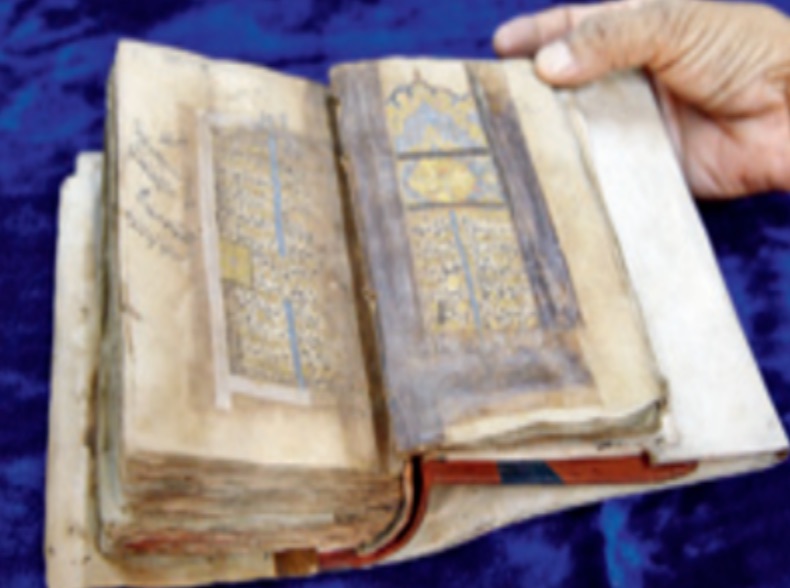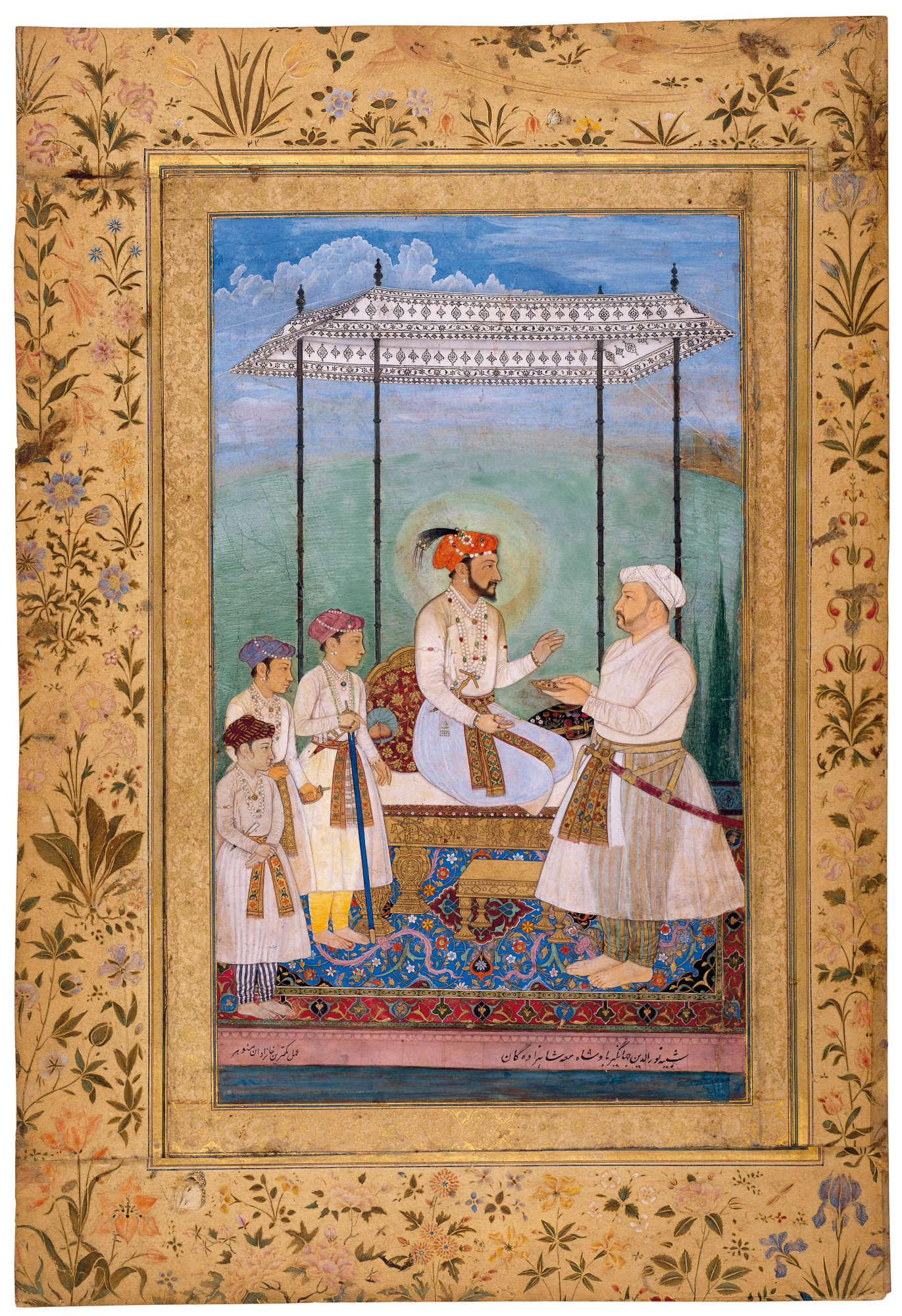The article “Persian poet’s 700-year-old manuscript, signed by Shah Jahan, at Asiatic Society” by Jhimli Mukherjee Pandey appeared in the Times of India on March 6, 2017. The version printed below has been edited, Kindly note that a number of images and accompanying captions inserted below do not appear in the original Times of India report.
= = = = = = = = = = = = = = = = = = = = = = = = = = = = =
The Persian poet Hafiz expressed the spiritual experiences of a mystic, in love with his beloved. In his own enchanting way, he wove themes of ambiguity into his poems. “A poet for the poets”, Hafiz immortalised words intimate, playful and hopefully real.

A copy of the Divan of Hafez housed at the National Museum of Iran in Tehran (Source: FabianKhan in Public Domain). This features Ghazals at the right and a typical Persian miniature at the left. The influence of Hafez’s (1315-1390) poetry has spread far beyond the Iranian realms into the Indian Subcontinent, the Ottoman Empire as well as Europe.
Now, nearly 700 years after the Persian great’s death, Asiatic Society has stumbled upon his handwritten manuscript -the ‘Divan-i-Hafiz’ -which is one of the very few such surviving manuscripts in the world. If that was not enough, the manuscript also contains an unpublished ghazal.
The news has sent the rich world of Persian literature into a tizzy and many scholars were recently in the city to catch a glimpse of the manuscript and take a closer look at its lines.

Researchers discovered the ‘Divan-e-Hafiz’ while going through the works of Mirza Ghalib (Source: Times of India).
Apart from the beautiful calligraphy, the manuscript bears the signature of Shah Jahan and his gold insignia. Hafiz lived and wrote much before the time of Shah Jahan, but the insignia means that the manuscript had landed in the Mughal emperor’s library, scholars said.

A Persian-style Mughal miniature depicting a seated Shah Jahan (r. 1628-1658) flanked to the left by his sons Dara Shukoh, Shah Shuja and Aurangzeb; to the right stands Asaf Khan IV, the maternal grandfather of Shah Jahan’s sons (Source: Mughal in Public Domain).
Asiatic Society has proudly displayed the manuscript in its museum, though it will not be kept in the open for long, considering its antique value and fragile condition.
Researchers discovered the `Divan-e-Hafiz’, yellow and brittle with age, while going through the works of Mirza Ghalib for an event on the occasion of the 220th birth anniversary of the Persian Urdu poet. Historian Ramkrishna Chatterjee, also the publications secretary of Asiatic Society, said:
“When our Persian scholars went through it, they were stunned. This was an original handwritten manuscript by Hafiz, who was nearly 500 years older than Ghalib. We started hunting for reference material to authenticate the manuscript. While we consulted Persian scholars who vouched for the authorship of the ghazal collection, we had to know how this manuscript reached us.”
Persian scholars from institutes all over the world participated in the Mirza Ghalib event. As noted by Syed Akhtar Hussain, associate professor of Persian at Jawaharlal Nehru University and president of the acclaimed Institute of Indo-Persian Studies:
“Finding Hafiz’s manuscript was an additional gain. We had never expected to see it here. We have read the unpublished poem `Beham Dillah Ke Bazam… Dedane Ruiyat Moiasser Shud…’ (Thank God, I have the honour of looking at your face again). This will make scholars of Persian literature make a beeline for the Society to catch a glimpse of this manuscript”.

Edwin Lord Weeks’ 1883 painting of the Taj Mahal currently housed at the Walters Art Museum (Source: Public Domain). This breathtaking structure, which was actually completed by 1648, is also a UNESCO World Heritage site. The master architect of Taj Mahal was an Iranian named ‘Ostad Isaa Afandi’ from Shiraz. The builders were also Persian stone masons, imported from Iran by Mogul Shah Jahan, as per the request of the aforementioned Chief Master Architect Afandi. The white marble for the Taj Mahal was imported from Isfahan. The calligraphy was created by the Persian calligrapher Abd ul-Haq, who came to India from Shiraz, Iran, in 1609. Shah Jahan conferred the title of “Amanat Khan” upon him as a reward for his “dazzling virtuosity”. Another striking Iranian influence can be seen in the design of the gardens and waterworks of the locale. Much of the fauna of Taj Mahal’s Persian gardens were directly imported from Iran. The term “Taj Mahal” is Persian for “The Royal Grounds” or more literally “The Crown Locale”.
As further averred by Syed Akhtar Hussein, a similar handwritten manuscript is preserved at Khuda Baksh Library in Patna. Ahmad Karimi Hakkak, professor of Persian literature at the University of Maryland stated:
“Since this Divan bears the signature of emperor Shah Jahan, it naturally adds to the authenticity of the manuscript. Hafiz wrote about 500 ghazals in his own hand. After his death, some of his students copied his manuscripts for greater dissemination. The earlier copies are also considered to be authentic, but since this one contains an unpublished ghazal, its authenticity is unquestioned”.
The question researchers are asking is why the manuscript bears the signature of Shah Jahan although Hafiz lived and wrote long before the Mughal Empire. As Hakkak further explained:
“Successive Mughal courts, right from the time of Humayun, have collected original manuscripts of Persian poets and Hafiz was naturally the most coveted figure. Mughal emperors would even gift manuscripts to other rulers and libraries were looted during wars. This is how manuscripts traveled”.



